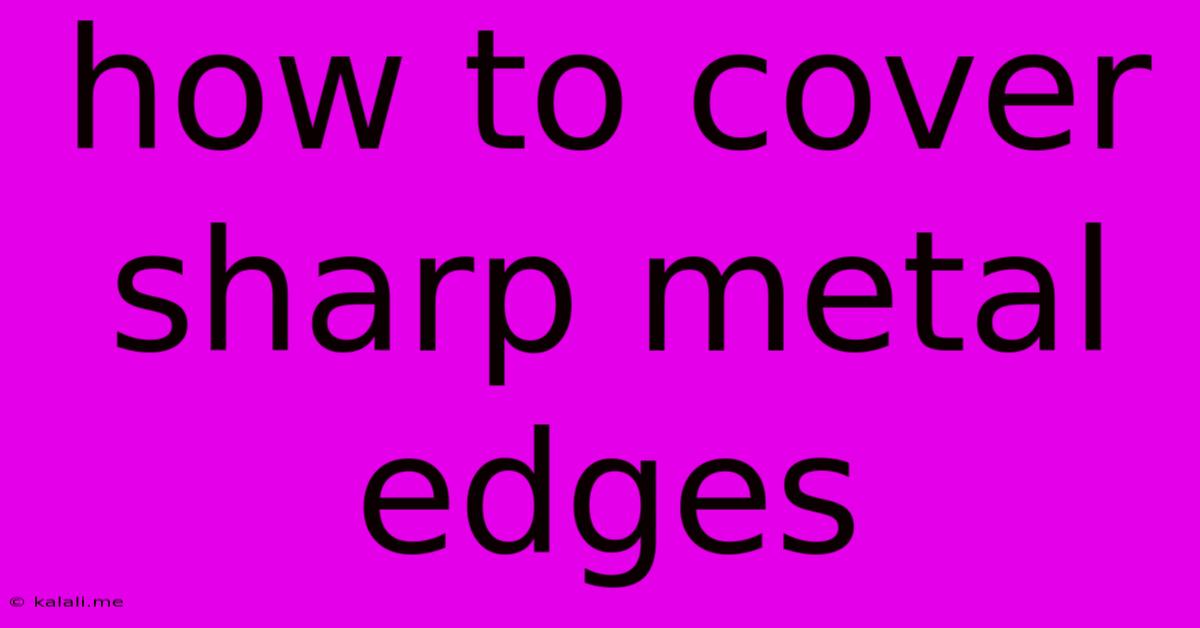How To Cover Sharp Metal Edges
Kalali
May 31, 2025 · 3 min read

Table of Contents
How to Cover Sharp Metal Edges: Safety and Aesthetics
Sharp metal edges pose a significant safety hazard, especially in homes and workplaces. Beyond the immediate risk of cuts and lacerations, they can also snag clothing and cause damage to other objects. This article will explore various methods for covering sharp metal edges, focusing on both safety and aesthetic considerations. Whether you're dealing with a rusty old toolbox or sleek modern furniture, we'll guide you through effective and practical solutions.
Assessing the Risk and Choosing the Right Solution
Before starting any project, it's crucial to assess the severity of the sharp edges. A slightly rough edge might only require minor sanding, while severely sharp or jagged edges may necessitate more robust protection. Consider the following factors:
- Sharpness: How sharp is the edge? A simple visual inspection should suffice for most cases.
- Material: Different metals require different treatment. Soft metals may be easier to file or sand, while harder metals might require more specialized tools and techniques.
- Location: The location of the sharp edge influences the choice of covering method. Edges on furniture require a different approach than edges on industrial equipment.
- Aesthetic Considerations: How important is the final look? Some methods are more aesthetically pleasing than others.
Methods for Covering Sharp Metal Edges
Here are several effective ways to cover sharp metal edges, ranging from simple DIY solutions to more professional methods:
1. Filing and Sanding: This is the simplest method for slightly sharp edges. Use a file to gently round off the sharp edges and then use progressively finer grades of sandpaper to smooth the surface. This is best for relatively soft metals and minor imperfections. Always wear appropriate safety glasses and a dust mask.
2. Protective Tape: For temporary protection or less-critical applications, consider using strong adhesive tape like gaffer tape or duct tape. This is a quick and easy solution, but it's not a long-term or aesthetically pleasing option. It's ideal for protecting edges during transportation or temporary storage.
3. Rubber or Plastic Edging: Pre-made rubber or plastic edging is readily available in various sizes and colors. This can be applied using adhesive, making it a relatively simple and effective solution for many applications. It offers good protection and a decent aesthetic finish.
4. Metal Edging: Metal edging provides a durable and professional-looking finish. It’s usually applied with rivets or screws, offering a more permanent solution. This is often used in industrial settings or for high-impact applications.
5. Welding: For severe damage or industrial applications, welding can be used to build up metal and create a smooth, rounded edge. This requires specialized skills and equipment. This is not a DIY project and should only be undertaken by experienced welders.
6. Protective Coatings: Applying a protective coating, such as paint or powder coating, can help to soften the edges and prevent further damage or corrosion. However, this doesn't physically cover the sharpness itself, but it can improve the overall safety and appearance.
Safety Precautions
Regardless of the method you choose, always prioritize safety:
- Wear appropriate safety glasses: This will protect your eyes from flying debris.
- Wear gloves: This will protect your hands from cuts and abrasions.
- Use appropriate tools: Ensure that your tools are in good condition and are suitable for the task.
- Work in a well-ventilated area: Some materials may release harmful fumes.
- Take breaks: Avoid fatigue, which can lead to mistakes and injuries.
By following these steps and choosing the appropriate method, you can effectively cover sharp metal edges, ensuring both safety and a more aesthetically pleasing finish. Remember to always prioritize safety and choose the method that best suits your needs and skill level.
Latest Posts
Latest Posts
-
Conda Activate D Activate Binutils Linux 64 Sh Line 67 Host Unbound Variable
Jun 02, 2025
-
What Does It Mean To Bless God
Jun 02, 2025
-
How To Send Exe File Through Email
Jun 02, 2025
-
Substitute For Milk Powder In Bread Recipe
Jun 02, 2025
-
Psql Create User If Not Exists
Jun 02, 2025
Related Post
Thank you for visiting our website which covers about How To Cover Sharp Metal Edges . We hope the information provided has been useful to you. Feel free to contact us if you have any questions or need further assistance. See you next time and don't miss to bookmark.